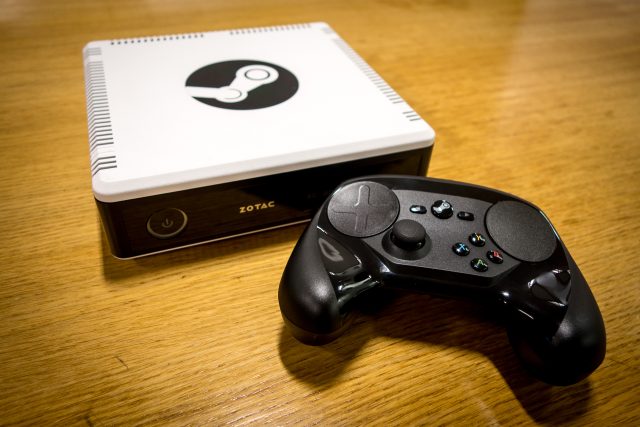
Pulling Zotac's SN970 Steam Machine from its box, first impressions are good. Despite the garish Steam logo on top, its small white case with black side panels is pleasingly understated. It's weighty, too—the "wow, this thing must be expensive!" kind of weighty that you'd hope for from a device that costs a substantial £900.
Despite being smaller than a PlayStation 4—and tiny compared to the hulking mass of an Xbox One—Zotac's Steam Machine is far more powerful thanks to the Intel Core i5 processor and Nvidia GTX 960 graphics card inside. I was really quite eager to plug it in and play some games. Then the problems started.
The last time I used SteamOS was in 2014, back when it was still in beta, and everyone was falling over themselves to declare Valve's latest invention the best thing to happen to video games since the d-pad. Since then, Steam Machines—the console-like PCs that ship with SteamOS—have been released... and the reviews haven't been kind to put it mildly. But how bad can it be? After all, we constantly complain about Windows and its constant need for updates and new graphics card drivers that can often make things worse rather than better. An OS designed to just get out of the way and let me play games? That can only be a good thing.
I dug out an HDMI cable and plugged the Zotac directly into the monitor on my desk, an old Asus PQ321 4K model. I wasn't expecting to run anything in 4K, but I often pipe consoles through it at 1080p and it works a treat. Pushing the large circular power button on the front of the Zotac, it sprang to life, illuminating a disarmingly bright blue LED on the front. You'll know if this thing is on from a mile away. It booted surprisingly quickly for a machine equipped with a 1TB spinning platter hard drive, presenting me with a login screen for me to enter my Steam account credentials.
And then it all started to go horribly wrong
The graphics, however, were interlaced (running in 1080i) with distracting artefacts that occurred every time I moved the mouse pointer with the Steam Controller. "No problem," I thought, "I'll just change the settings when I login."
That, however, was easier said than done. Trying to type using the Steam Controller and the on-screen keyboard with its weird split layout is difficult enough at the best of times, but the visual artefacts made it nigh on impossible. I gave up and fetched a USB keyboard and mouse from the cupboard.
-
Zotac's SN970 impressive hardware is easy to open up and upgrade. There's space for another stick of memory, and a M.2 SSD as standard.
-
On the front there's a card reader, microphone jack, headphone jack, and USB type-C socket.
-
There are two Ethernet jacks, four HDMI outputs, USB 2.0, and USB 3.0.
Once logged in I tried to find the display settings to fix the resolution issue, but all I could find was a setting to adjust underscan or overscan. Surely adjusting something as basic as the screen resolution must be possible? I took to Google, and it turns out that, no, you can't adjust the screen resolution from within the SteamOS Big Picture Mode. I quit Steam and jumped out to the Linux desktop, hoping that changing the settings there would fix the problem. It did not. Changes made to the Linux desktop settings, where the interlacing was fixed, don't translate into Steam.
So I took to Google again, browsing the Internet from the SteamOS desktop and its pre-installed Iceweasel browser in search of an answer. Multiple forum threads suggested that I edit a settings file located in /usr/bin/steamos/set_hd_mode.sh, adding or removing the resolutions that I wanted. I opened a terminal window and tried to open the text editor Nano with the sudo command in order to edit the file. Sadly, I couldn't because an admin password hadn't been set, and not being a Linux whiz, I didn't know how to set one. Back to to Google.
I found the command needed to set the password, put one in, and resumed trying to edit the file in Nano. Despite my efforts, however, I couldn't get Nano to display the text in the settings file correctly. I tried downloading a GUI-based editor by opening up the "packages" app. I opted for Gedit.
Finally, I was able to correctly display the settings file and make edits. I saved it, rebooted the Zotac, and hoped for the best. It didn't work.
I tried again, this time trying to force a 720p resolution. That didn't work either. I booted up Bioshock Infinite—one of the few AAA Linux-compatible games available—hoping that maybe, just maybe, it wouldn't be interlaced in-game. I was wrong.
I turned off the Zotac and unplugged the keyboard and mouse and HDMI and power cables from the back. I carefully cleaned it with a small cloth, placing it back in the box along with the power supply and Steam Controller. Then, making sure all the relevant manuals and paperwork were inside the box, I sealed it up with some tape, and put it back in the cupboard ready to be sent on to another journalist. I wondered whether they would have the same experience I did, or if I was just unlucky.
I turned on my Windows PC to play Just Cause 3. It worked perfectly.
reader comments
425